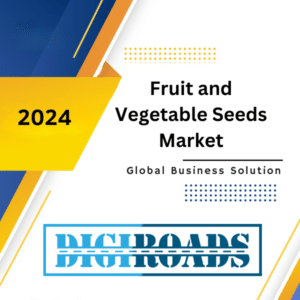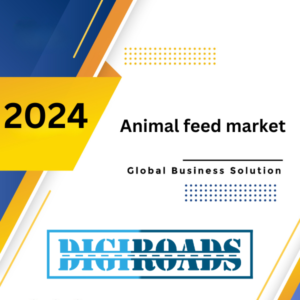Description
Animal Feed Additives Market: Opportunity Analysis and Industry Forecast, 2024-2034
Animal Feed Additives Market Overview:
The feed additives market is estimated at USD 46.18 billion in 2024 and is projected to reach USD 75.71 billion by 2034, at a CAGR of 5.3% from 2024 to 2034.
The animal feed additives market plays a critical role in the global livestock industry by enhancing the nutritional value, health, and productivity of animals. These additives include vitamins, minerals, amino acids, enzymes, antibiotics, probiotics, and prebiotics, among others. The market is driven by factors such as increasing meat consumption, rising demand for high-quality animal products, and the need for improved feed efficiency.
The intensification of animal farming practices and the focus on maximizing productivity have led to widespread adoption of feed additives to enhance animal performance and well-being. Additives like antibiotics and growth promoters prevent diseases and improve growth rates, while enzymes and probiotics aid in digestion and nutrient absorption. Moreover, the growing concerns about food safety and the preference for sustainable farming practices are driving the demand for natural and alternative feed additives.
Asia Pacific dominates the animal feed additives market, led by countries such as China and India, owing to the expansion of the livestock industry. However, North America and Europe also hold significant market shares due to advanced farming practices and stringent regulations. Overall, the animal feed additives market is expected to continue growing as the demand for high-quality animal products and sustainable farming practices increases globally.
Animal Feed Additives Market – Report Coverage:
The “Animal Feed Additives MarketReport – Forecast (2024-2034)” by Digiroads Consulting, covers an in-depth analysis of the following segments in the Agrochemical Market.
| Attribute | Segment |
| By Type |
|
| By Animal Type |
|
| By Animal Headcount |
|
| By Location |
|
Recent Developments :
Focus on Natural and Organic Additives:
- Driven by consumer preference for animal products raised without antibiotics or hormones, there’s a surge in demand for natural and organic feed additives. This includes probiotics, prebiotics, essential oils, and botanical extracts.
Plant-Based Feed Additives:
- Sustainability concerns are driving research into plant-based alternatives to traditional feed additives. Examples include enzymes derived from plants to improve nutrient digestibility and feed efficiency.
Innovation in Gut Health Management:
- Gut health is increasingly recognized as crucial for animal health, performance, and immunity. Development of new feed additives targeting gut microbiome balance and promoting beneficial bacteria is a key trend.
Technological Advancements:
- Advancements in areas like precision fermentation and encapsulation technologies are enabling the creation of more potent and targeted feed additives with improved delivery and efficacy .
Regulatory Landscape:
- Regulatory bodies are closely monitoring the use of feed additives, particularly antibiotics used for growth promotion. This is leading to a shift towards alternatives and a focus on responsible use of additives
Animal Feed Additives Market- Dynamics:
.Growth Drivers:
- Livestock Population Growth: The global livestock population is projected to rise, particularly in developing countries. This will drive demand for feed additives to enhance animal productivity and meet the growing demand for meat, milk, and eggs.
- Focus on Feed Efficiency: With increasing feed costs and environmental concerns, improving feed efficiency through additives that enhance nutrient utilization is a major focus.
- Disease Prevention and Immunity Boosters: Feed additives play a crucial role in preventing diseases, promoting gut health, and strengthening animal immunity. This translates to reduced mortality rates and improved animal well-being.
Shifting Trends:
- Demand for Sustainable Practices: Sustainability is becoming a key consideration. This includes the use of eco-friendly feed additives derived from natural sources and reduced reliance on synthetic additives with potential environmental impact.
- Precision Fermentation for Novel Additives: Advancements in precision fermentation are enabling the production of novel feed additives like next-generation enzymes and amino acids, offering improved efficacy and targeted functionality.
Regulatory Landscape:
- Stringent Regulations on Antibiotics: Stricter regulations on the use of antibiotics as growth promoters is a major driver for alternative feed additives. This is pushing innovation towards prebiotics, probiotics, and other natural solutions.
- Focus on Safety and Traceability: Regulatory bodies are emphasizing the safety and traceability of feed additives. This necessitates robust quality control measures throughout the production chain.
Key Market Players:
Product/Service launches, approvals, patents and events, acquisitions, partnerships and collaborations are key strategies adopted by players in the Animal Feed Additives Market. The top 10 companies in this industry are listed below:
- Novozymes
- DSM
- Adisseo
- Chr. Hansen Holding
- Cargill
- ADM
- Ajinomoto Co.
- SHV
- Evonik Industries
- DuPont
- Kemin Industries
Key Benefits For Stakeholders:
- Farmers:
-
- Improved Animal Health: Feed additives enhance the health and well-being of livestock, reducing the incidence of diseases and improving overall productivity.
- Increased Productivity: Additives like growth promoters and probiotics improve growth rates, feed conversion ratios, and reproductive performance, leading to higher yields and profitability.
- Cost Savings: Enhanced feed efficiency and reduced veterinary costs contribute to cost savings for farmers.
- Feed Manufacturers:
- Product Differentiation: Offering feed with added value through specialized additives allows manufacturers to differentiate their products in the market.
- Enhanced Product Quality: Additives improve the nutritional quality and safety of animal feed, meeting the diverse needs of farmers and consumers.
- Increased Market Share: Providing a wide range of innovative additives attracts more customers, leading to increased market share and revenue.
- Suppliers:
- Expanded Product Offerings: Suppliers benefit from offering a diverse range of feed additives, meeting the evolving needs of farmers and feed manufacturers.
- Partnerships and Collaborations: Collaborating with manufacturers and farmers to provide technical support and education on feed additives enhances the value proposition for suppliers.
- Revenue Growth: Increased demand for feed additives translates into revenue growth opportunities for suppliers.
- Consumers:
- Safe and Nutritious Animal Products: Feed additives contribute to the production of safe, high-quality animal products such as meat, eggs, and dairy.
- Assurance of Animal Welfare: Enhanced animal health and well-being ensure consumers that animals are raised under optimal conditions.
- Food Safety: Reduced use of antibiotics and improved feed quality contribute to food safety by minimizing the risk of residues and contamination in animal products.
We have studied the Animal Feed Additives Market in 360 degrees via. both primary & secondary research methodologies. This helped us in building an understanding of the current market dynamics, supply-demand gap, pricing trends, product preferences, consumer patterns & so on. The findings were further validated through primary research with industry experts & opinion leaders across countries. The data is further compiled & validated through various market estimation & data validation methodologies. Further, we also have our in-house data forecasting model to predict market growth up to 2034.
Contact us for any inquiry.
Table of Contents
- INTRODUCTION
1.1 Study Assumptions & Market Definition
1.2 Scope of the Study
- RESEARCH METHODOLOGY
- EXECUTIVE SUMMARY
- MARKET DYNAMICS
4.1 Market Overview
4.2 Market Drivers
4.3 Market Restraints
4.4 Porter’s Five Forces Analysis
4.4.1 Bargaining Power of Suppliers
4.4.2 Bargaining Power of Buyers
4.4.3 Threat of New Entrants
4.4.4 Threat of Substitute Products
4.4.5 Intensity of Competitive Rivalry
- MARKET SEGMENTATION
- By Type
- Amino Acids
- Vitamins & Minerals
- Antioxidants & Others
- By Animal Type
- Cattle
- Poultry
- Swine & Others
- By Animal Headcount
- Poultry
- Ruminants
- Swine
- By Location:
- Africa
- Asia-Pacific
- Europe
- Middle East
- North & South America
- COMPETITIVE LANDSCAPE
6.1 Most Adopted Strategies
6.2 Market Share Analysis
6.3 Company Profiles
- Novozymes
- DSM
- Adisseo
- Chr. Hansen Holding
- Cargill
- ADM
- Ajinomoto Co.
- SHV
- Evonik Industries
- DuPont
- Kemin Industries
- MARKET OPPORTUNITIES AND FUTURE TRENDS





